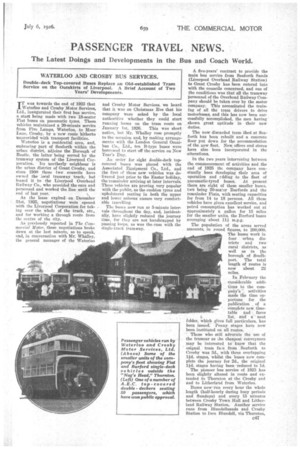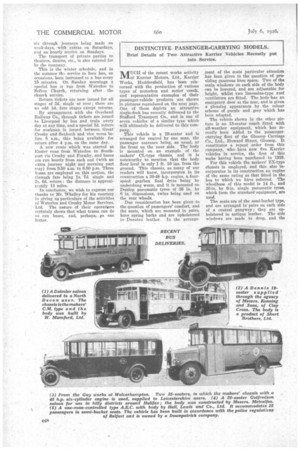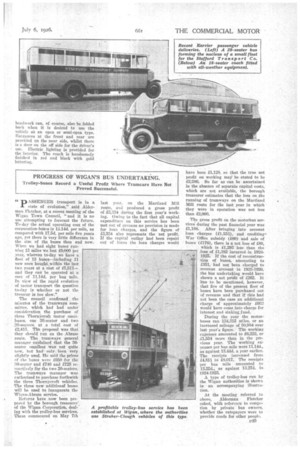PASSENGER TRAVEL NEWS.
Page 37

Page 38

Page 39

If you've noticed an error in this article please click here to report it so we can fix it.
The Latest Doings and Developments in the Bus and Coach World.
WATERLOO AND CROSBY BUS SERVICES.
Double-deck Top-covered Buses Replace an Old-established Tram Service on the Outskirts of Liverpool. A Brief Account of Two Years' Developments.
IT was towards the end of 1923 that Waterloo and Crosby Motor Services, Ltd., inaugurated their first bus service, a start being made with two 18-seater Fist buses in pneumatic tyres. These vehicles maintained a 20-minute service from Five Lamps, Waterloo, to Moor Lane, Crosby. by a new route hitherto tuiprovided with transport facilities.
Waterloo is a residential area, and, embracing part of Seaforth within the urban district, adjoins the Borough of Bootle, the latter being served by the tramway system of the Liverpool Corporation. Its northerly neighbour is the urban district of Great Crosby, and since 1900 these two councils have owned the local tramway track, but leased it to the Liverpool Overhead Railway Co., who provided the cars and personnel and worked the line until the end of last year.
As the lease expired on December 31st, 1925, negotiations were opened with the Liverpool Corporation for taking over the whole of the track, etc., and for working a through route from the centre of the city.
As previously reported in The Commercial Motor. these negotiations broke down at the last minute, so 'to speak, and, in conversation with Mr. Whalley, the general manager of the Waterloo
and Crosby Motor Services. we heard that it was on Christmas Eve that his company were asked by the local authorities whether they could start running buses on the tram route on January 1st, 1926. This was short notice, but Mr. Whalley rose promptly to the. occasion and, by making arrangements with the London General Omnibus Co.. Ltd., ten B-type buses were borrowed to start off the service on New Year's Day.
An order for eight double-deck to covered buses was placed with the Associated Equipment Co., •Ltd., and the first of these new • vehicles was delivered just. prior to the Easter holiday, the remainder arriving at later intervals. These vehicles are proving, very popular with the public, as the cushion tyres and upholstered seating in both the upper and lower saloons ensure very comfortable travelling.
The buses now run at 5-minute Intervale throughout the day, and, incidentally, have slightly reduced the journey time, for they are not handicapped by passing loops, as was the.case with the single-track tramway. A five-years' contract to provide the main bus service front Seaforth Sands (Liverpool Overhead Railway Station) to Great Crosby has been entered into with the councils concerned, and one of the conditions was that all the tramway personnel of the Overhead Railway Company should be taken over by the motor company. This necessitated the training of all the tram drivers to drive motorbuses, and this has now been successfully accomplished, the men having shown great aptitude in their new duties.
The now discarded tram Shed at Seaforth has been rebuilt and a concrete floor put down for the accommodation of the new fleet. New offices and stores have also been incorporated in the alterations.
In the two years intervening between the commencement of activities and the end of 1925 ths company have constantly been developing their area of operation and rdding to the fleet of pneumatic-tyred buses. At present there are eight of these smaller buses, two being 20-sea4er Burfords and the remainder Fiats, with seating capacities for from 14 to 18 persons. All these vehicles have given excellent service, and petrol consumption has worked out at approximately a gallon for 15 miles for the smaller units, the Burford buses averaging about 111 m.p.g.
The population of the areas served amounts, in round figures, to 200,000. The buses work in four urban districts and two rural districts, as well as in the borough of Southport. The total length of routes is now about 22 miles.
In February the considerable additions to the company's activities made the time opportune for the publication , of a complete new timetable and fares k list, and a ' neat folder, which gives full particulars, has been issued. Penny stages have now been instituted on all routes.
Those who still advocate the use of the tramcar as the cheapest conveyance may be interested to know that the orignal tram fase from Seaforth to Crosby was 3d., with three overlapping lid. stages, whilst the bases now complete the journey for 2d., the original 1-id stages having been to 1d.
The pioneer bus service of 1923 has been slightly altered in route and extended to Thornton at the Crosby end and to Litherland from Waterloo.
Buses now-run every hour the whole length (half-hourly during busy periods and Sundays) and every 15 minutes between Crosby Town Hall and Litho.land Railway Station. Another service runs from Blundellsands and Crosby Station to Ince 131undell, via Thornton,
six through journeys being made on week-days, -with extras on Saturdays, and an hourly service on Sundays.
The transport of private parties to theatres, dances, etc., is also catered for by the company.
This is the winter schedule, and in the summer thy! service to Ince has, on occasions, been increased to a bus every 15 minutes. On Sunday mornings a special bus is run from Waterloo to Sefton Church, returning after the church service.
Return tickets are now issued for all stages of 3d. single or over; there are no odd ucl. fare stages except returns. • By arrangement with . the Overhead Railway Co., through tickets are issued to Liverpool by bus and train every day at any time, and a special 3d. return for workrrien is issued between Great 'Crosby an Seaforthand vice versa before 8 a.m., this being available for return after 4 p.m. on the same day. A new route 'which was started at Easter runs from -Waterloo to Southport via Crosby and Formby, and buses are run hourly from each end (with an extra journey night and morning part way) from 9.50 a.m. to 8.50 p.m. Three buses are employed on this section, the through fare being 1s. 7d: single and 2s. 6d. return ; the distance is approximately 13 miles. In conclusion, we wish to express our thanks to Mr. Whalley for his courtesy in giving us particulars of the activities of Waterloo and Crosby Motor Services, Ltd. The nature of their operations certainly shows that what trams can do so can buses, and. perhaps, go one better. ityrUCH of the recent works activity Karrier Motors, Ltd., Karrier Works, Huddersfield, has been concerned with the production of various types of motorbus and motor coach, and representative examples of their passenger-vehicle products are shown in pictures reproduced on the next page. One of these depicts an attractive single-deck bus recently delivered to the Stafford Transport Co., and is one of seven vehicles of a similar type which will ultimately he delivered to this company. This vehicle is a 29-seater and is arranged for control by one man, the passenger entrance being, as usual, at the front on the near side. The body is mounted on an example of the makers' CL-type chassis, and it is noteworthy to mention that the body floor level is only 1 ft. 10 ins. from the ground. This chassis, as many of our readers will know, incorporates in its construction a 30-48 h.p. engine, a fourspeed gearbox final drive being by underslung worm, and it is mounted on Dunlop pneumatic tyres of 36 in. by 6 in. dimensions, twins being used on the rear wheels. Due consideration has been given to the question of passengers' comfort, and the seats, which are mounted in pairs, have spring backs and are upholstered in Duratax leather. In the arrange ment of the seats particular attention has been given to the question of providing generous knee space. Two of the main windows on each side of the body can be lowered, and are adjustable for height, whilst two limousine-type roof ventilators are fitted. The body-has an emergency door at the rear, and is given a pleasing appearance by the colour scheme of purple and grey which has been adopted. The vehicle shown in the other picture is an 18-seater coach fitted with all-weather equipment, which has recently been added to the passengercarrying fleet of the Glossop Carriage Co., Ltd., Howard Street, Glossop. It constitutes a repeat order from this company, who have now five Karrier vehicles in service, the first of this make having been purchased in 1919. For this vehicle the makers' ZX-type chassis is employed, and this also incorporates in its construction an engine of the same rating as that fitted in the bus to which we have referred. The wheelbase of this model is 14 ft., and 36-in. by 6-in, single pneumatic tyres, which form the standard• equipment, are used. The seats are of the semi-bucket type, and are arranged in pairs on each side of a central gangway; they are upholstered in antique leather. The side windows are made to drop, and the 44 13AS8ENGER transport is in a -IL state of evolution," said Alderman Fletcher, at a recent meeting of the Wigan Town Council, "and it is no use attempting to forecast the future. To-day the actual operating cost of the corporation-buses is 11:14d. per mile, as compared with 17.5d. per mile five years ago, yet there is very little difference in the size of the buses then and now. When we had eight buses running 13 Miles we lost £9000 Per year, whereas to-day we have a. fleet of 13 buses—including 11 new ones bought within the last two years at a crust of £7,511-and they can be operated at a cost of 11..14d. per bus mile. In view of the rapid evolution of motor transport the question to-day is whether or not the tramcar is too slow."
The council confirmed the minutes of the tramways committee, which had had under consideration the purchase of three Thorn5Troft motor omnibuses, o-ae 36-seater and two 20-seaters, at a total cost of £2,415. The proposal was that they should run on the Abram route. The tramways general manager explained that the 86seater omnibus was not quite new, hut had only. been very slightly used, rfe said the prices af the buses were £950 for the 36-seater and £740 and £725 respectively for the two 20-seaters. The tramways manager was authorized to purchase forthwith the three Thornycroft vehicles, The three new additional buses will be used to inaugurate the Wigan-Abram service.
Returns have now been pre pared by the borough treasurer' of the Wigan Corporation, dealing with the trolley-bus services. These commenced on May 7th
last year, on the Martland Mill route, and produced a gross profit of /3,334 during the first year's working. Owing, to the fact that all capital expenditure on this service has been met out of revenue no provision is made for loan charges, and the figure of £3,334 also represents the net profit. If the capital outlay had been repaid out of loans the loan charges would have been 11,128, so that the true net profit on working mai' be stated to be £2,206. So far as can be ascertained in the absence of separate capital costs, which are not available, the borough treasurer estimates that the loss on ,the running of tramways on the Martian(' Mill route for the last year in which they were in operation was not less than £2,000.
The gross profit on the motorbus services during the past financial year was £1,188. After bringing into account loan charges (£1,553), and crediting. War Office subsidy (£80) and sale of buses (£176), there is a net loss of £89, which is 11,293 less than the loss of £1,382 incurred in 19241925. If the cost of reconstruction of buses, anaounting to £351, had not been charged to revenue account in 192.5-1926, the bus undertaking would have shown a net profit of £262. It has to be mentioned, however, that five of the present fleet of buses have been purchased out of revenue and that if this had not been the case an additional charge of approximately £662 would have came into charge for interest and sinking fund.
During the year the motorbuses ran 134,315 miles, or an increased mileage of 50,984 uver last year's figure. The working expenses amounted to £6,222, or £1,554 more than in the pro: vious year. The working expenses per bus mile were 11.14d., as against 13.44d. a year earlier. The receipts increased from 14,811 to £8,017. The receipts per bus mile amounted to 13.55d., as against 13.27d. in 1924-1925.
A type of trolley-bus run by the Wigan authorities is shown in an accompanying illustration.
At the meeting referred to above, Alderman Fletcher asked, with reference to competion by private bus owners, whether the ratepayers were to provide roads for other people.
















































